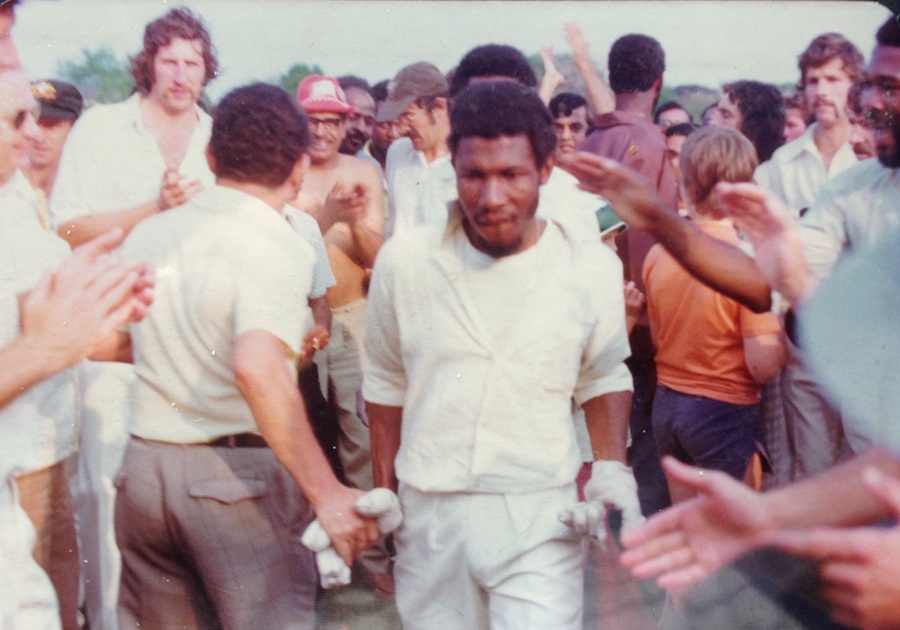When Canada Defeated Australia - Chappell, Lillee, Marsh and Co in 1975
Patrick Pisani | June 02, 2025

The Toronto Cricket Skating and Curling Club were very happy and fortunate to host the Australian National Cricket team for three games on their beautiful grounds in May 1975. The weather was ideal, the anticipation was high and, in the end, the event was the greatest episode in Canadian cricket in the decade of the seventies.
We all know the results of the first match when Australia met the Eastern Canada representative team. It made news worldwide. But few know the details of the match. And few know about the valiant performances of some key individuals on the victorious side.
There is some mumbling that the welcoming party the night before had some effect on the match. I was present, and it was a very happy get together. But it was not the first time that an Australian cricketer enjoyed a Fosters. And it was not the first time a Canadian cricketer of Caribbean descent enjoyed an Appletons.
The Australian team was billeted within walking distance of the batting crease. They didn’t have to worry about a morning commute. If there was any haziness, the opportunity to bat first meant nine Australians could enjoy the spring sunshine and watch their opening batsmen, as the host Eastern Canada team took the field.
The action on the field, which was enjoyed by more than 3,000 spectators, who were humming with great expectation, unfolded quickly.
Roy CalIender, a lanky right arm fast bowler, born in the Caribbean, resident of Montreal, showed why he was a frequent member of the Canadian National Cricket team in the 1970s. He quickly dismissed the Australian opener, Rick McCosker, caught by Marshall Desouza, for one run.
The scoreboard read 1 for 1.
From the other end the outstanding all rounder of The Toronto Cricket Skating and Curling Club, Rick Stevens, a left arm quick bowler, who could move the ball through the air and off the pitch with enviable accuracy, took the wicket of number three batsman Alan Turner for two runs, caught by Jitu Patel. The Australians were “down under”.
Ian Chappell strokes a Rick Stevens delivery for 2 backward of point
In a matter of minutes the Canadians had ratcheted up the drama. The paying spectators had already received their money’s worth. The epic day, the perfect weather, the ideal setting were unfolding in a captivating way.
Greg Chappell 20 and Bruce Laird 32, directed the Aussies past 50 runs before Canadian left arm orthodox leg spinner, from London, Ontario, Jitu Patel inflicted his vital impact.
He had Greg Chappell, perhaps the best batsman in the world at the time, caught and bowled. He dismissed Laird.
Greg Chappell executes a beautiful cover drive off Jitu Patel for four
He had Doug Walters smartly stumped by Selwyn Griffith, of Ottawa.
Rick Stevens took care of Australia captain, Ian Chappell, perhaps the best batman in the world at the time, caught in the slips by The Toronto Cricket Club’s Ray Nascimento for two runs.
Selwyn Griffith stumps Doug Walters off Jitu Patel’s leg spin
The visitors were now teetering on the edge of ignominious defeat at 88 for 6!
Highly regarded wicketkeeper Rodney Marsh, a left handed batsman, fought back with a solid innings of 55 runs before he was caught on a running outfield catch by Canada’s Captain Garnet Brisbane, of Montreal.
Marsh was the only visitor to have success on the day. Callender came on for his second spell to clean up the “Tail Enders”!
The improbable had occurred. Unbelievable was witnessed by the bedazzled spectators.
Outstanding Canadian bowlers Patel, Callender and Stevens had sent the Australian cricket team back to The Toronto Cricket Skating and Curling Club locker room for 159 runs!
Now the tea time interval with the scoreboard reading, “159 all out Australia”, led to the greatest teatime discussions in the history of the Toronto Cricket Skating and Curling Club. The spectators mused that it was a sufficient total. The visiting team were confident that they could protect that total.
The Eastern Canada side’s opening batsman Brian Hale conjectured, “An opportunity missed is an opportunity lost”. For Brian this was an opportunity of a lifetime.
Number three Ray Nascimento had scored a record-setting 170 runs for Canada against the United States National Team on this ground only a few years earlier. He imagined that he could show that form again today.
Number four batsman Franklyn Dennis, who as a teenager in Jamaica was often mistaken for his contemporary, Lawrence Rowe, when people saw his fluid stroke play off of quick bowlers, anticipated that he might have an important role to play.
What would the Ladbrokes betting line be? I wonder.
The Australian team took the field and captain Ian Chappell tossed the ball to Dennis Lillee at the south end. Lillee looked like a Greek God, a tall figure of strength and power, a legendary fast bowler for the ages - tossing thunderbolts.
Brian Hale, was a diminutive figure. My guess 5 foot 5. My guess 150 pounds. Brian was always one of the top run-getters in the Toronto league through the 1970s.
These two contrasting figures were about to engage in a cricket battle. In the great game of cricket, this is a fair fight!
Umpires Harris Lawson and Imery Strasser set the bails.
As Lillee took his first stride in his long run-up the crowd became silent. As the first ball a little short of a length zipped passed Hale into wicketkeeper Rodney Marsh’s gloves the audience “Whooooed” in a unified hum at the speedy delivery.
Dennis Lillee’s lightning bolt speeds towards Brian Hale
On the second delivery Lillee raced to the stumps, whipped his arm over and delivered a short rising ball passing high near Hale. Hale defiantly raised his bat and ramped the ball over the slips, with a shot that was uncommon at the time, but is now part of every opening batsman’s weaponry.
The ball flashed towards third man and bounced off the bowling-green-like grass in the outfield and rushed towards the Toronto Cricket Club’s bowling green. Four runs.
Diminutive stature and helmetless, Hale had captured the moment.
Hale repeated the ramp-shot when opportunity presented itself and ran up 32 runs surprisingly quickly before the enraged Lillee ripped out Hale’s off stump with a lightning bolt.
The scoreboard read 56 for 1.
Montréal’s Victor Green was dismissed in the next over by Max Walker for 18 runs on a Doug Walters catch.
Ray Nascimento and Dennis became the new partnership at the crease and added 40 runs to the tally. With the score at 98, Nascimento was caught by Hurst for 16 runs to the bowling of James Higgs, Australia's best leg-spinner between Benaud and Warne. Next Higgs removed Larimer and Brisbane.
At the other end Franklyn Dennis showed comfort in his precise defensive strokes off the back foot.
He displayed intense concentration and patience. Like Hale, his short stature almost made him immune to the bouncer.
Franklyn was a frequent centurion in the Toronto league. When he came to the crease Canada needed 102 runs. Franklyn measured his innings and he calibrated, clearly and confidently that if he came not out, he would come off the field victorious. His pet shot was the cover drive off the backfoot. He started to bank runs employing that stroke.
A renowned name in Canadian cricket, Rick Stevens, a very accomplished left-hand batsman throughout the 1970s, was now at the crease. He recognized that if he came not out, the mission would be accomplished. He steadied one end and watched with great pleasure as his partner took most of the strike.
In cricket, the turning point could be the very next ball. So Australia persisted, after all, only hours before, as the spectators had witnessed, when Marsh was dismissed, Oz had nothing left. Would this be the same for Canada if Dennis failed?
For the visiting team it became a death by 1000 cuts. A single here and a single there, and then a sudden square cut by Dennis to the boundary.
It was not the fact that Lillee, Walker and Hurst, the Australian fast bowlers underestimated the talent of the Canadian batsmen. It was the fact that the Canadian batsmen were talented. They clearly demonstrated the ability to withstand the pace.
Cricket is a multifaceted game. It does not have to be won with powerful Chris Gayle sixes. On this day it could be won with impenetrable defence. You do not have to offer a shot at a ball that will not hit the wicket. Singles accumulate. Punish the loose ball. All the basic first lessons of batting that Dennis learned as a teenager in Jamaica, he brought to the TCSCC ground that day.
Franklyn Dennis completed and innings of one hour and 47 minutes scoring an invaluable 57 not out. He and Rick Stevens steered the Eastern Canada team to a five wicket victory much to the amazement of the transfixed spectators. Under the bright sun at this immaculate TCS&CC ground, this was certainly a glorious moment for Canada.
Dennis Lillee and Max Walker combined to bowl 25 overs taking two wickets for 90 runs.
It was not Lawrence Rowe who had the victorious innings against Australia. On this day, when the Canadian Cricket Team captured its most famous victory, the name we remember is Franklyn Dennis!
The Canadian batting hero Franklyn Dennis departs surrounded by an excited crowd followed by Rick Stevens. Lillee, McCosker, Walker and Hurst applaud
BeaconPoint Club Clips - Why Leadership in Community Sport is important with Pat Cummins - Australian Cricket captain










